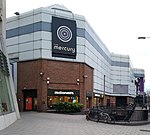Romford Garden Suburb (otherwise known as the Gidea Park Exhibition Estate), is a late-Edwardian housing development in Gidea Park, in the London Borough of Havering. The object of the new suburb, which was built on land belonging to Gidea Hall, then occupied by the Liberal politician Herbert Raphael, was, according to his parliamentary colleague John Burns, to "provide families with a well-built, modern home regardless of class or status" and "to bring the towns into the country and the country into the towns".
The garden suburb was conceived to be an example of early 20th-century domestic architecture and town planning. They were popular in Edwardian England; Hampstead Garden Suburb, established by Henrietta Barnett in 1906, was one example. The garden suburb at Romford comprised 159 fully-furnished houses and cottages each funded by the architects who designed them, in either the Arts and Crafts or Art Nouveau styles. Upon completion an exhibition was organised to showcase the dwellings for prospective buyers and a competition was held to find the best building, with a first prize of £250 and a gold medal being awarded to the winning architect. The best detached houses were awarded Class I status, which would allow the property to be sold for £500, while Class II buildings were marketed for £375. The buildings were judged on their utility and economy of management and maintenance.
One hundred architects and urban planners took part in the Gidea Park development, including William Curtis Green, Philip Tilden, Raymond Unwin, Richard Barry Parker, George Val Myer, Geoffry Lucas and Baillie Scott. The exhibition opened in the spring of 1911 and with it came the establishment of several roads, including Balgores Lane, Squirrels Heath Avenue and Crossways to the south of Hare Street (now Main Road) and Heath Drive, Meadway, Reed Pond Walk, Heaton Grange Road, Risebridge Road and Parkway to the north. In 1934, using land left over from the first competition, a second exhibition was held, this time hosted by Raphael's nephew, Major Ralph Raphael MC. These houses were designed in the Art Deco style, a taste that was dominant at the time. Six of the 1911 exhibition houses were later designated as Grade II listed buildings by Historic England. The suburb was designated as a conservation area in 1970. The winner of the 1934 competition, 64 Heath Drive, by Francis Skinner, a founding member of Berthold Lubetkin's Tecton Group, was also listed at Grade II in 1997.








